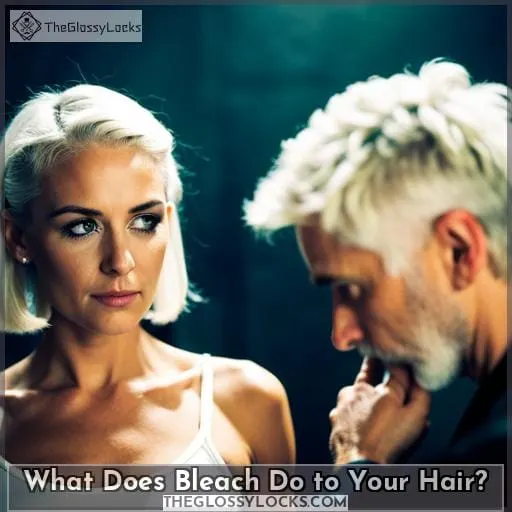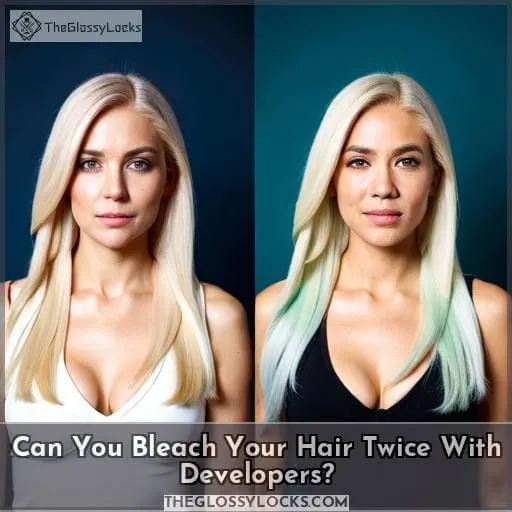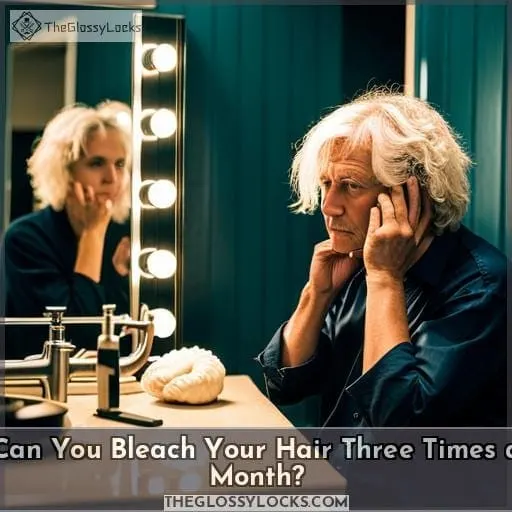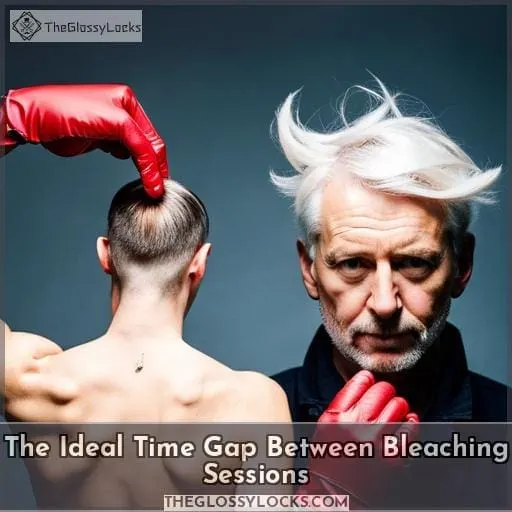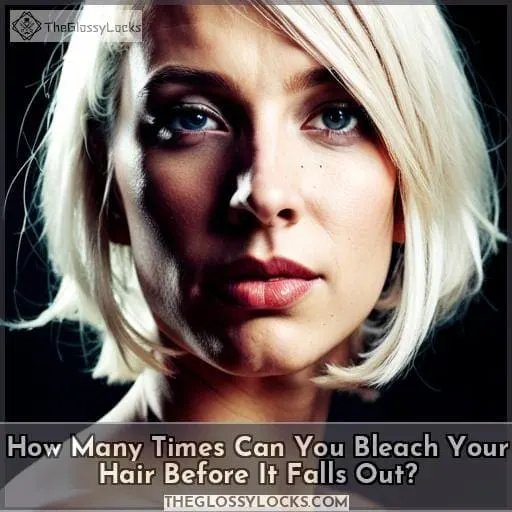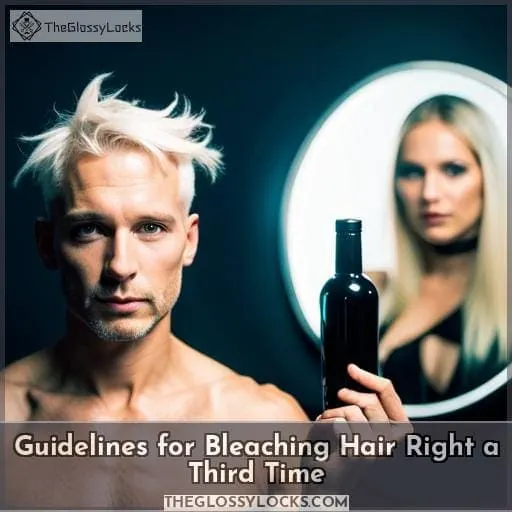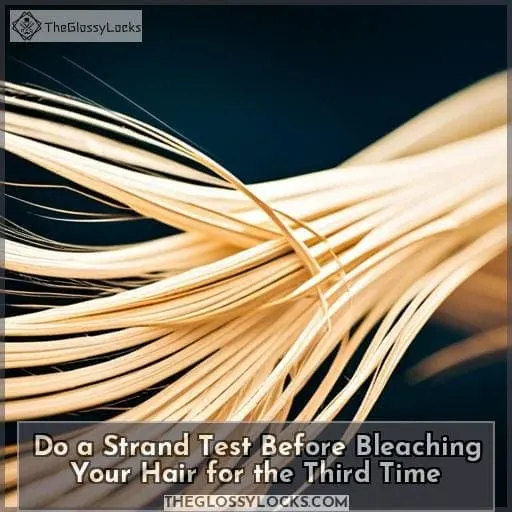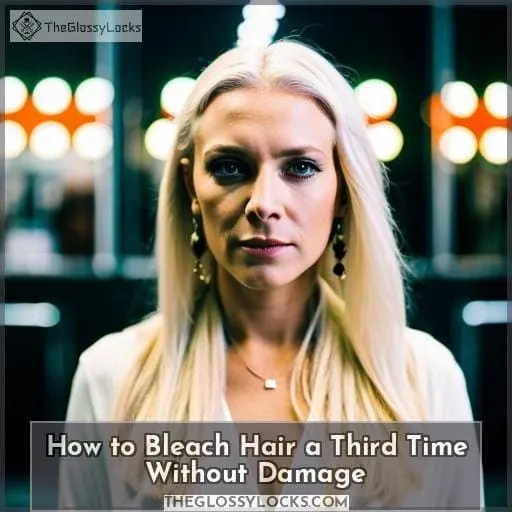This site is supported by our readers. We may earn a commission, at no cost to you, if you purchase through links.
You’ve dyed your hair and love the result. You want to maintain the look by bleaching it a second time. However, before considering a third bleach, there are certain things to take into account. Over-bleaching can have serious repercussions on your hair. In this article, we will discuss what happens if you bleach your hair for a third time and how to protect it from damage during the process.
Table Of Contents
- Key Takeaways
- What Does Bleach Do to Your Hair?
- How to Choose the Right Developer Volume for Bleaching?
- Can You Bleach Your Hair Twice With Developers?
- Can You Bleach Your Hair Three Times a Month?
- The Ideal Time Gap Between Bleaching Sessions
- How Many Times Can You Bleach Your Hair Before It Falls Out?
- Guidelines for Bleaching Hair Right a Third Time
- Do a Strand Test Before Bleaching Your Hair for the Third Time
- How to Bleach Hair a Third Time Without Damage
- Frequently Asked Questions (FAQs)
- How long should I wait between bleaching sessions?
- Is it possible to bleach my hair more than three times in a month?
- What is the best volume of developer to use for bleaching?
- Is it necessary to do a strand test before bleaching my hair a third time?
- How can I protect my hair when bleaching a third time?
- Conclusion
Key Takeaways
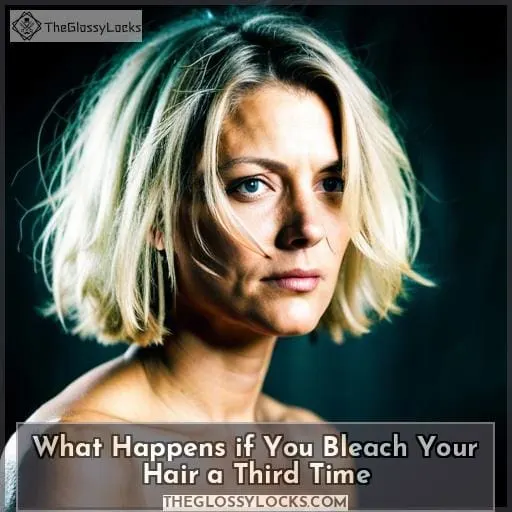
- Bleaching hair repeatedly can lead to thinning and split ends.
- It is important to pay attention to visible signs of damage.
- Deep conditioning treatments and protein bonds should be used between each process.
- To bleach hair a third time, follow guidelines for pre-bleach care, hair protection, toning tips, and developer selection.
- Consult with a professional colorist to minimize potential risks.
What Does Bleach Do to Your Hair?
Bleaching your hair can be a fun and exciting way to change up your look, but it’s important to remember that bleaching is also a chemical process. Repeated bleaching can severely weaken and damage your hair, leaving it dry and prone to breakage.
It’s essential to take certain precautions before you start the process of bleaching if you want healthy results.
Before beginning each session of bleach application, make sure that the gap between two sessions should not be less than 8-10 weeks for best results. This will allow time for hydration treatments so that the strands’ health does not suffer too much from repeated chemical processes.
Additionally, ensure adequate strand testing to properly select developer volumes (5-40). For optimal effects, use volume 20 or a maximum of 30 developers when applying bleach powder with hydrogen peroxide solution together with coconut oil applied beforehand as protection against damage caused by harsh chemicals present in these products.
After rinsing off any product residue using cold water and regular shampoo, follow up immediately with a moisturizing conditioner rinse, ensuring all areas are covered before allowing air drying. Air drying should never exceed a 20-minute limit at one sitting. As an extra step after drying, consider toning treatment depending on the desired final color tone, once more minimizing risk factors associated with overbleached locks.
How to Choose the Right Developer Volume for Bleaching?
When bleaching hair, it is important to choose the right volume of developer for the best results. Different strengths of hydrogen peroxide are available in volumes 5, 10, 20, 30, and 40. Volume 20 is most commonly used as it lifts the cuticle enough to allow bleach into the hair shaft while still protecting its health and preventing too much damage from chemical exposure.
Higher levels may be necessary depending on how dark or resistant a person’s natural color or dye is, but should only be used if absolutely necessary as there can be lasting effects from over-bleaching your hair such as dryness and breakage.
It’s also important not to leave bleach on for too long. Twenty minutes is the maximum time with any strength developer before rinsing thoroughly with cold water followed by an application of conditioner after shampooing out all traces of product residue.
To find out what level would work best for you without risking permanent harm, always opt for a strand test first. This will give you an indication of whether your desired shade can realistically be achieved using lower volumes (such as 10) versus higher ones (30-40).
Additionally, ensure that prior bleaches have been given ample waiting time between sessions so that they do not overlap each other.
With proper care before, during, and after the process, selecting the correct amount per individual need won’t lead in the wrong direction!
Can You Bleach Your Hair Twice With Developers?
It’s not recommended to bleach your hair twice in a row with developers, as double bleaching can strip away natural oils and leave hair more vulnerable to damage, over-bleaching can cause severe hair damage. The developer strength and amount of time you leave the product on are both important factors that can affect your hair’s health.
The volume of developer you should use depends on how long you’ve been dyeing your hair or what color it currently is. Typically, using 20 vol developer is sufficient enough when bleaching dyed strands, but first consider the processing time for 20 vol developer, which depends on hair type and desired lift. If needed, 30 vol may be used with caution due to increased risks for further damage beyond dryness and breakage.
It’s important to remember that any type of chemical process needs some rest period between sessions. Waiting at least 8-10 weeks before doing a second round helps maintain healthy tresses while reducing potential harm caused by too much exposure from chemicals like hydrogen peroxide found in most developers and toners afterwards.
Doing regular strand tests every few months or after major changes such as multiple bleaches helps ensure the integrity of each individual strand. This allows you to identify areas where more attention may need extra care either through hydration masks treatments or avoiding additional coloring during those times until restoring desired levels back into their optimal state again.
To get the best results from this process, it’s always suggested taking precautions prior to committing yourself to another session. Otherwise, irreversible effects such as extreme thinning and split ends might appear, leading towards inevitable premature loss.
Can You Bleach Your Hair Three Times a Month?
Are you considering bleaching your hair for the third time this month? It’s important to be aware of safety precautions and understand the limits when it comes to bleaching. While coloring or lightening your hair can help achieve desired results, too much of a good thing can also cause irreversible damage.
Here are five things you should consider before taking on a third bleaching session:
- Hair Health – Bleached hair needs extra care between sessions, as it tends to become drier and more brittle with each chemical process. A strand test will indicate how healthy your strands are prior to any further color treatments.
- Developer Strength – The most commonly used developer volume is 20, but if necessary, choose a maximum volume of 30 depending on the dye already applied.
- Damage Prevention – Applying coconut oil helps reduce damage from bleach, while conditioning masks help in recovery after chemical processes.
- Bleaching Limits – Don’t leave bleach on for more than 20 minutes during the session and wait at least three weeks before getting another one done again.
- Third Time Color – Guidelines must be followed carefully if opting for a third time color or tone change so that no additional damage occurs beyond repairable levels.
Following these guidelines will ensure that you maintain healthy locks without compromising the quality of life due to damaged tresses!
The Ideal Time Gap Between Bleaching Sessions
You should wait 8-10 weeks between bleaching sessions to ensure healthy hair. Bleaching your hair is an effective way to change up your look, but it can also be damaging if not done correctly. If you’re considering bleaching for the third time in a month, it’s important that you take certain precautions and understand the risks involved.
The ideal time gap between two consecutive bleachings is 8-10 weeks so that your hair has enough time to recover from each session without becoming too weakened or dry. Before beginning any new process, make sure you have all of the necessary information about different levels of developer and how they will affect your locks before deciding on which one would be best for achieving desired results with minimal damage caused by chemical processing.
Additionally, do a strand test beforehand so that you are aware of how well each type works on strands individually as opposed to using average results based off general experience with previous clients’ treatments or other sources found online.
This essential step helps provide insight into what volume of developer would be most beneficial while still protecting hair’s natural integrity as much as possible during treatment regimes such as color options or natural alternatives like henna dyes and herbal rinses instead when feasible due precautionary measures needed throughout the entire procedure.
Proper knowledge regarding these topics gives preventative methods against extreme effects over long period use, allowing more control over individual beauty choices. Ultimately, resulting in successfully meeting desired outcomes safely within given parameters while keeping potential hazards at bay, providing peace of mind and confidence to achieve appearance dreams and desires confidently, enjoying newfound freedom associated with beautiful transformation experiences gained.
How Many Times Can You Bleach Your Hair Before It Falls Out?
Repeatedly bleaching your hair weakens its structure and can lead to breakage. It’s important to protect the health of your hair by limiting the amount of times you bleach. Generally speaking, there is no set limit on how many times you can safely bleach your hair before experiencing damage.
However, three or more sessions in a short period of time can be too much for some people’s locks.
If you are considering a third session within 8-10 weeks from the last one, make sure that deep conditioning treatments and protein bonds have been used between each process. It’s also important to pay attention to any visible signs of damage like split ends or dryness when deciding whether or not another round is right for you.
Don’t forget about those pesky roots! If these signs are present after two rounds, then continuing would only cause further harm. However, if they aren’t noticeable yet, then an additional session may still be possible depending upon factors such as overall condition and strength level prior to treatment beginning again.
Making this conscious decision requires trust in yourself because ultimately only YOU know what is best for YOUR own beautiful mane! To prevent any further issues, try using protective products including moisturizing masks during all stages post-bleach along with regular trimming/deep repair treatments afterwards since damaged strands need extra TLC!
Guidelines for Bleaching Hair Right a Third Time
If you’re considering bleaching your hair for the third time, there are certain precautions you should take to ensure it’s done right. The first step is to make sure that your hair has received proper pre-bleaching care and has had sufficient time (at least 8-10 weeks) between bleachings.
You should also protect your hair from damage by applying coconut oil before beginning the process. Additionally, selecting an appropriate volume of developer – no more than 30 – and toning tips can help minimize any potential harm caused by overprocessing or underprocessing.
Finally, when it comes to bleaching techniques for a third session, consulting with a professional colorist who knows what they’re doing will go a long way in helping achieve desired results while maintaining healthy locks.
- Pre-Bleach Care: Before bleaching again, make sure previous sessions have had enough recovery time.
- Hair Protection: Apply coconut oil prior to beginning the process.
- Toning Tips: Use purple shampoo and conditioner after each session.
- Developer Selection: Choose maximum volume 30 developer only.
- Bleaching Techniques: Consult a professional colorist for the best procedure.
Bleaching one’s own hair without proper knowledge can lead to disastrous consequences. Seeking advice from professionals on how best to achieve the desired results would provide satisfactory results both aesthetically and functionally.
Do a Strand Test Before Bleaching Your Hair for the Third Time
Before committing to a third bleaching session, do a strand test to determine your hair’s resistance. This will give you an idea of how much bleach volume and pre-bleaching care is needed for the desired blonde shade.
By taking this precaution, you can be sure that your hair health won’t suffer too much damage from the process.
A strand test involves applying some bleach on a single piece of hair from either behind or underneath your head so as not to disturb existing hairstyle, if any. Results of these tests should be monitored closely, and you should act accordingly depending on what it reveals – whether further protection such as coconut oil needs adding before starting with bleaching or if post-bleaching treatment like conditioners are necessary afterwards.
Following the results carefully also helps in deciding which level of developer is right for achieving blondeness without damaging strands more than required.
After completing one cycle, wait at least 8 weeks before doing another round since overdoing it may cause irreversible harm done due to excessive use of chemicals within a short time span. Lastly, when rinsing off bleach, always use cold water instead of hot because high temperature could strip away natural oils present in the scalp, leaving them exposed and prone to breakage.
Finally, rinse thoroughly until lather disappears completely – all traces need to be gone to prevent dryness or irritation caused after chemical exposure during the process.
Taking into account these caring tips while bleaching guarantees healthy tresses that look beautiful naturally!
How to Bleach Hair a Third Time Without Damage
After doing a strand test to see if your hair can withstand the process, you may be ready to bleach your hair a third time. To do this without damage, it is important that certain steps are taken and precautions are observed.
Firstly, use the best possible developer for bleaching – volume 20 or maximum 30. Apply coconut oil before bleaching as it helps protect the scalp and hair from chemical burns during processing. Additionally, never leave bleach on longer than 20 minutes and always rinse with cold water afterwards using regular shampoo containing no harsh chemicals like sulfates or parabens.
A rest period of at least 8-10 weeks is highly recommended between each session in order to allow your hair enough time to recover its natural state after being exposed to such strong chemical processes twice already.
Remember that healthy, hydrated locks will help keep any potential risks low when it comes to trying home bleaching treatments. So make sure you follow up regularly with nourishing masks and conditioners specially designed for relaxing hair care routine.
The healthiest thing would be leaving some more days before risking damaging those precious tresses again, but if not possible, just take all necessary precautions beforehand while taking into consideration what happened last time (if anything).
Frequently Asked Questions (FAQs)
How long should I wait between bleaching sessions?
Before bleaching your hair for a third time, it’s best to wait 8-10 weeks. Allow your locks to recover with nourishing masks and conditioner. Visualize the process as you hydrate your strands – strong, healthy hair will endure the chemical treatment! Unlock powerful results by taking proper precautions between sessions and cherishing your mane.
Is it possible to bleach my hair more than three times in a month?
It is not recommended to bleach your hair more than three times in a month. Doing so can cause dryness, damage, and even hair loss. It is best to wait 8-10 weeks between bleaching sessions and ensure that your hair is healthy before proceeding.
If you must bleach your hair for the third time, take precautions as it could be disastrous if done incorrectly.
What is the best volume of developer to use for bleaching?
The optimal volume of developer to use for bleaching is This will raise the cuticle and enable you to achieve your desired color without excessively weakening or damaging your hair.
Is it necessary to do a strand test before bleaching my hair a third time?
Absolutely! If you’re considering bleaching your hair for the third time, it’s essential to do a strand test first. A strand test will reveal if the hair can withstand such harsh chemicals and help protect against dryness or breakage – both of which could be disastrous! So don’t take chances: always do the strand test before bleaching.
How can I protect my hair when bleaching a third time?
To protect your hair during a third bleaching, use a volume 20 developer or lower and apply coconut oil to strengthen its resistance. Leave the bleach on for a maximum of 20 minutes, then rinse with cold water and follow up with a hydration mask.
By taking these precautions, you can safely achieve beautiful bleached locks without compromising the health of your hair.
Conclusion
It’s crucial to be mindful of the amount of bleaching you subject your hair to, as too much can cause permanent damage. It’s best to wait at least 8-10 weeks between bleaching sessions and be sure to do a strand test beforehand.
As the old adage goes, An ounce of prevention is worth a pound of cure, and that holds true here. By taking the time to properly prepare your hair for bleaching, you can avoid any lasting damage. Take your time and follow the necessary steps, and you’ll be able to bleach your hair safely and effectively.

